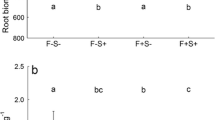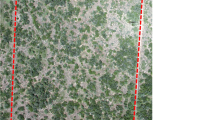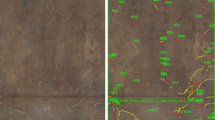Abstract
Eleven Midwest North American grassland plant species differed in theirconstruction, production, and placement of fine and coarse belowground biomassin the soil profile after having been grown in containers in the field for twoand a half growing seasons. Based on the patterns of root system structure andresource utilization, the species we examined could be classified as 1)legumes,2) high-nitrogen rhizomatous C3 species, and 3) a separategradient of differentiation from tall- to short-statured species(i.e. tallgrass to shortgrass species). Legumes depleted water evenlythroughoutthe soil profile, with little capacity for acquisition of inorganic nitrogenthroughout the 1m soil profile. The three rhizomatous species had shallow fineroot distributions, a large relative investment in shallow rhizomes, andmoisture and NO3 − levels were low in shallow soils,but high at depth. Tallgrass species maintained a large standing root biomassofhigh-density, low-nitrogen fine roots, and acquire nitrogen andwater from a large, deep volume of soil, in which inorganic nitrogen is presentin low concentrations. Root systems ofshortgrass species lacked coarse belowground biomass, had fine roots that werefiner than those of the tallgrass species, and had a shallow root distribution.There was little support for functional dichotomies between the C3and C4 species or between the grasses and forbs. For example,Solidago rigida (C3 forb) andAndropogon gerardii (C4 grass) were moresimilarto each other than to other C3 forbs or C4 grasses,respectively.Across all species and depths examined, there were strong relationships betweenthe amount of fine root biomass present in a unit of volume of soil and thedepletion of soil water and nitrogen, but there were no relationships withcoarse belowground biomass. This reaffirms that differentiation of coarse andfine root biomass is as important as differentiating stems and leaves inevaluating plant allocation and ecosystem functioning.
Similar content being viewed by others
References
Aerts R., Boot R.G.A. and Van der Aart P.J.M. 1991. The relation between aboveground and belowground biomass allocation patterns and competitive ability. Oecologia 87: 551–559.
Albertson F.W. and Tomanek G.W. 1965. Vegetation changes during a 30-year period in grassland communities near Hays Kansas. Ecology 46: 714–720.
Albertson F.W. and Weaver J.E. 1944. Nature and degree of recovery of grassland from the great drought of 1933 to 1940. Ecological Monographs 14: 393–479.
Canadell J., Jackson R.B., Ehleringer J.R., Mooney H.A., Sala O.E. and Schulze E.D. 1996. Maximum rooting depth of vegetation types at the global scale. Oecologia 108: 583–594.
Clarke S.E., Tisdale E.W. and Skoglund N.A. 1943. The effects of climate and grazing practices on short-grass prairie vegetation. Dom. Can., Dept. Agr. Tech. Bul 46.
Collins S.L., Glenn S.M. and Roberts D.W. 1993. The hierarchical continuum concept. Journal of Vegetation Science 4: 149–156.
Coupland R.T. 1950. Ecology of Mixed Prairie in Canada. Ecological Monographs 20: 271–315.
Coutts M.P. 1987. Developmental processes in tree root systems. Can J For Res 17: 761–767.
Craine J.M., Tilman D.G., Wedin D.A., Reich P.B., Tjoelker M.J. and Knops J.M.H. The relationship between plant functional strategies and growth in a low-nitrogen habitat. Functional Ecology (in press).
Curtis J.T. 1959. The Vegetation of Wisconsin. University of Wisconsin Press.
Diaz S. and Cabido M. 1997. Plant functional types and ecosystem function in relation to global change. Journal of Vegetation Science 8: 463–474.
Eissenstat D.M. 1997. Trade-offs in root form and function. In: Jackson L.E. (ed.), Ecology in Agriculture. Academic Press Inc., San Diego, California, USA, pp. 173–199.
Fitter A. 1996. Characteristics and functions of root systems. In: Waisel Y., Eshel A. and Kafkafi U. (eds), Plant Roots: The Hidden Half Marcel Dekker., New York, pp. 1–20.
Grime J.P., Thompson K., Hunt R., Hodgson J.G., Cornelissen J.H.C., Rorison I.H. et al. 1997. Integrated screening validates primary axes of specialisation in plants. Oikos 79: 259–281.
Hooper D.U. and Johnson L. 1999. Nitrogen limitation in dryland ecosystems: Responses to geographical and temporal variation in precipitation. Biogeochemistry 46: 247–293.
Hopkins H.H. 1951. Ecology of the native vegetation of the loess hills in central Nebraska. Ecological Monographs 21: 125–147.
Jackson R.B., Canadell J., Ehleringer J.R., Mooney H.A., Sala O.E. and Schulze E.D. 1996. A global analysis of root distributions for terrestrial biomes. Oecologia 108: 389–411.
Jackson R.B., Moore L.A., Hoffmann W.A., Pockman W.T. and Linder C.R. 1999. Ecosystem rooting depth determined with caves and DNA. In: Proceedings of the National Academy of Sciences of the United States of America., pp. 11387–11392.
Kindscher K. and Tieszen L.L. 1998. Floristic and soil organic matter changes after five and thirty-five years of native tallgrass prairie restoration. Restoration Ecology 6: 181–196.
Kindscher K. and Wells P.V. 1995. Prairie plant guilds: A multivariate analysis of prairie species based on ecological and morphological traits. Vegetatio 117: 29–50.
Körner C. 1984. Biomass fractionation in plants: a reconsideration of definitions based on plant functions. In: Roy J. and Garnier E. (eds), A Whole Plant Perspective on Carbon-nitrogen Interactions. SPB Academic Publishing, Inc., The Hague, pp. 173– 185.
Leishman M. and Westoby M. 1992. Classifying plants into groups on the basis of associations of individual traits—evidence from Australian semi-arid woodlands. Journal of Ecology 80: 417–424.
Nedrow W.W. 1937. Studies on the ecology of roots. Ecology 18: 27–52.
Nepstad D.C., De Carvalho C.R., Davidson E.A., Jipp P.H., Lefebvre P.A., Negreiros G.H. et al. 1994. The role of deep roots in the hydrological and carbon cycles of amazonian forests and pastures. Nature 372: 666–669.
Parrish J.A.D. and Bazzaz F.A. 1976. Underground niche separation in successional plants. Ecology 57: 1281–1288.
Ryser P. 1996. The importance of tissue density for growth and life span of leaves and roots: A comparison of five ecologically contrasting grasses. Functional Ecology 10: 717–723.
Sala O.E., Golluscio R.A., Lauenroth W.K. and Soriano A. 1989. Resource partitioning between shrubs and grasses in the Patagonian steppe. Oecologia 81: 501–505.
Sala O.E., Lauenroth W.K. and Golluscio R.A. 1997. Plant functional types in temperate semi-arid regions. In: Smith T.M.S., F.I. and Woodward H.H. (eds), Plant functional types: Their relevance to ecosystem properties and global change. Cambridge University Press, Cambridge, England, pp. 217–233.
Schimel D.S., Kittel T.G.F., Knapp A.K., Seastedt T.R., Parton W.J. and Brown V.B. 1991. Physiological interactions along resource gradients in a tallgrass prairie. Ecology 72: 672–684.
Seastedt T.R. 1995. Soil systems and nutrient cycles of the North American prairie. In: Joern A.K. and K.H. (eds), The changing prairie: North American grasslands. Oxford University Press, Oxford, England, pp. 157–174.
Silberbush M. and Barber S. 1983. Sensitivity of simulated phosphorus uptake to parameters used by a mechanistic-mathematical model. Plant and Soil 74: 93–100.
Sperry T.M. 1935. Root systems in Illinois prairie. Ecology 16: 178–202.
Tilman D. 1988. Plant strategies and the dynamics and function of plant communities. Princeton University Press, Princeton.
Tilman D., Knops J., Wedin D., Reich P., Ritchie M. and Siemann E. 1997. The influence of functional diversity and composition on ecosystem processes. Science 277: 1300–1302.
Tilman D. and Wedin D. 1991. Plant traits and resource reduction for five grasses growing on a nitrogen gradient. Ecology 73: 685–700.
Tilman D., Wedin D. and Knops J. 1996. Productivity and sustainability influenced by biodiversity in grassland ecosystems. Nature 379:718–720.
Tinker P.B. and Nye P.H. 1977. Solute movement in the soil-root system. University of California Press, Berkeley.
Waterman W.G. 1919. Development of root systems under dune conditions. Botanical Gazette 68: 22–53.
Weaver J.E. 1947. Rate of decomposition of roots and rhizomes of certain range grasses in undisturbed prairie soil. Ecology 28: 221–240.
Weaver J.E. 1958a. Classification of root systems of forbs of grassland and a consideration of their significance. Ecology 39: 393–401.
Weaver J.E. 1958b. Summary and interpretation of underground development in natural grassland communities. Ecological Monographs 28: 55–78.
Weaver J.E. 1968. Prairie Plants and their Environment: a fifty year study in the Midwest. University of Nebraska Press.
Weaver J.E. and Bruner W.E. 1945. A seven-year quantitative study of succession in grassland. Ecological Monographs 15: 298–319.
Weaver J.E. and Darland R.W. 1947. A method of measuring vigor of range grasses. Ecology 28: 146–162.
Weaver J.E. and Darland R.W. 1949. Soil-root relationships of certain native grasses in various soil types. Ecological Monographs 19: 303–338.
Weaver J.E., Hougen V.H. and Weldon M.D. 1935a. Relation of root distribution to organic matter in prairie soil. Botanical Gazette 96: 389–420.
Weaver J.E., Jean F.C. and Crist J.W. 1922. Development and activities of roots of crop plants. Carnegie Inst., Washington.
Weaver J.E., Stoddart L.A. and Noll W. 1935b. Response of the prairie to the great drought of 1934. Ecology 16: 612–629.
Weaver J.E. and Zink E. 1946a. Annual increase of underground materials in three range grasses. Ecology 27: 115–127.
Weaver J.E. and Zink E. 1946b. Length of life of roots of ten species of perennial range and pasture grasses. Plant Physiology 21: 201–217.
Wedin D.A. 1995. Species, nitrogen and grassland dynamics: the constraints of stuff. In: Jones C. and Lawton J.H. (eds), Linking Species and Ecosystems. Chapman and Hall, New York, pp. 253–262.
Wedin D.A. and Pastor J. 1993. Nitrogen mineralization dynamics in grass monocultures. Oecologia 96: 186–192.
Wedin D.A. and Tilman D. 1993. Competition among grasses along a nitrogen gradient: Initial conditions and mechanisms of competition. Ecological Monographs 63: 199–229.
Woodward F.I., Smith T.M. and Shugart H.H. 1997. Defining plant functional types: the end view. In: Woodward F.I., Smith T.M. and Shugart H.H. (eds), Plant Functional Types: Their Relevance to Ecosystem Properties and Global Change. Cambridge University Press, Cambridge, UK, pp. 355–359.
Yanai R.D., Fahey T.J. and Miller S.L. 1995. Efficiency of nutrient acquisition by fine roots and mycorrhizae. In: Smith W.K. and Hickley T.M. (eds), Resource Physiology of Conifers. Academic Press, San Diego, USA, pp. 75–103.
Author information
Authors and Affiliations
Corresponding author
Rights and permissions
About this article
Cite this article
Craine, J., Wedin, D., Chapin, F. et al. Relationship between the structure of root systems and resource use for 11 North American grassland plants. Plant Ecology 165, 85–100 (2003). https://doi.org/10.1023/A:1021414615001
Issue Date:
DOI: https://doi.org/10.1023/A:1021414615001




